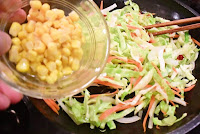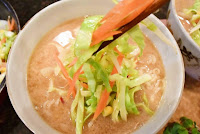Finally, a sodium-savvy ramen with plenty of vegetables and great-tasting soup! More toppings mean more soup going into your mouth, especially when toppings are cut or sliced into small sizes, as a greater surface area is likely to carry more soup into your mouth. So for a reduced-sodium version, having lots of toppings is counter-intuitive, yet we opted for julienned vegetables for the extra flavor they add.
1/2 of recipe (approx. half of soup left in bowl):
515 calories; 17.0 g protein; 9.3 g fat; 88.1 g carbohydrate; 15.8 g net carbs; 781 mg sodium* (with reduced-sodium miso and shoyukoji made with 50% reduced-sodium soy sauce); 11 mg cholesterol; 7.5 g fiber; 706 mg potassium
*Stir-fried vegetable toppings alone contain 100 mg sodium per serving.
<Ingredients>
500 cc strong niboshi-kobu (shiitake) dashi; made with the following ingredients
12 g niboshi dried young sardines (heads and bellies removed)
2 g kombu kelp
1 g hoshi-shiitake dried shiitake mushroom (1 stem part used)
700-800 cc water
200 cc chicken stock
100 g additive-free tonyu soymilk (or whole milk)
2 tsp sakekasu sake lees
3 tbsp miso
1 tbsp shoyukoji soy sauce rice malt
2 tsp oyster sauce
For topping
Yasai itame stir-fried vegetables (made with approx. 350 g vegetables)
Approx. 150-160 g cabbage (166 g in photo)
1 small carrot (39 g in photo)
1/2 small onion (90 g in photo)
60 g corn kernels (canned, no salt added)
2 taka no tsume red chili pepper (slices in photo)
1 knob ginger
1 clove garlic
1/4 tsp kurozu brown rice vinegar
1/2 tsp shiokoji salted rice malt
1/2 tsp oil
1 green onion (24 g in photo)
Tiny handful kaiware daikon sprouts (5 g in photo)
10 g unsalted butter (optional)
Black pepper
<Directions>
1.
Prepare niboshi-kobu (shiitake) dashi.
Dry toast niboshi until aromatic.
Add kombu kelp, dried shiitake and water, and let sit for hours, if possible.
Bring to boil (at very low heat, if not having let sit).
Before boiling, remove kombu, and simmer down to 500 cc on medium low to low heat for 30-40 minutes, while skimming foam that appears on surface from time to time.
Strain, and obtain 500 cc (if not enough, add water).
Niboshi-kobu (shiitake) dashi is ready.
2.
Start preparing soup.
In a small pot, put sakekasu, niboshi-kobu (shiitake) dashi and chicken stock, and bring to boil on medium heat.
Dissolve sakekasu as necessary.
Add shoyukoji, oyster sauce and miso, mix well, and keep warm.
3.
Start boiling water for ramen noodles.
4.
Prepare toppings.
Grate ginger and garlic. Somewhat thickly julienne carrot and cabbage. Slice onion.
Cut off root ends of kaiware daikon sprouts, and thinly slice green onion.
5.
When water boils, cook noodles according to package instructions or to desired softness.
6.
Heat oil, and fry vegetables in the order of tough texture.
Here, saute carrot first, then add onion and cabbage on medium low or lower heat.
Add taka no tsume red chili pepper and kurozu brown rice vinegar, and continue frying.
When almost done (vegetables are softened), add ginger and garlic, and continue frying.
Add corn and shiokoji, and mix well.
Yasai itame stir-fried vegetables are ready.
7.
When noodles and vegetables are almost ready, add tonyu to soup mix, and heat through (do not boil, as boiling tends to coagulate soymilk).
8.
When ramen noodles are ready, drain, and serve in individual bowls.
9.
Heat soup to almost bubbling, and pour over noodles.
Put yasai itame stir-fried vegetables.
Top with green onion slices, kaiware daikon sprouts and butter, and grind black pepper.
Serve hot.
- When you eat ramen, leaving more soup significantly reduces the overall amount of sodium you get. We both take a few sips of soup and leave most of the soup in the bowl.
- Salt level of the soup above is 0.8% (315 mg sodium per 100 g soup). The average of ramen soup at restaurants is around 1.5% (591 mg sodium per 100 g soup).
- The above nutrition figures, other than sodium, are based on the assumption that 50% of soup is consumed. The sodium figure is calculated on the basis of measurement of soup left in bowls.
- Using a smaller amount of toppings helps to further reduce sodium intake (because toppings catch soup as you eat, you end up taking sodium from soup as well).
- Sodium content of seasonings I used above:
- Miso paste: 580 mg/tablespoon (18 g)
- Shoyukoji soy sauce rice malt: 299 mg/tablespoon (18 g)
- Oyster sauce (a Thai brand): 440mg/tablespoon (18 g)
- Sodium content of niboshi-kobu (shiitake) stock above is 452 mg (0.23%).
- Ramen noodles used here are by Miyakoichi (photo at right: sodium content of 153 mg per 90g dry noodles; when boiled with 3,000-4,000 cc water, little sodium is left in noodles).
- For toppings, any vegetable works great -- cabbage and moyashi bean sprouts (photo at right) are all-year-round popular choices. Asparagus (photo below) is a delicious choice for spring.

(Last updated: July 19, 2019)




























No comments:
Post a Comment